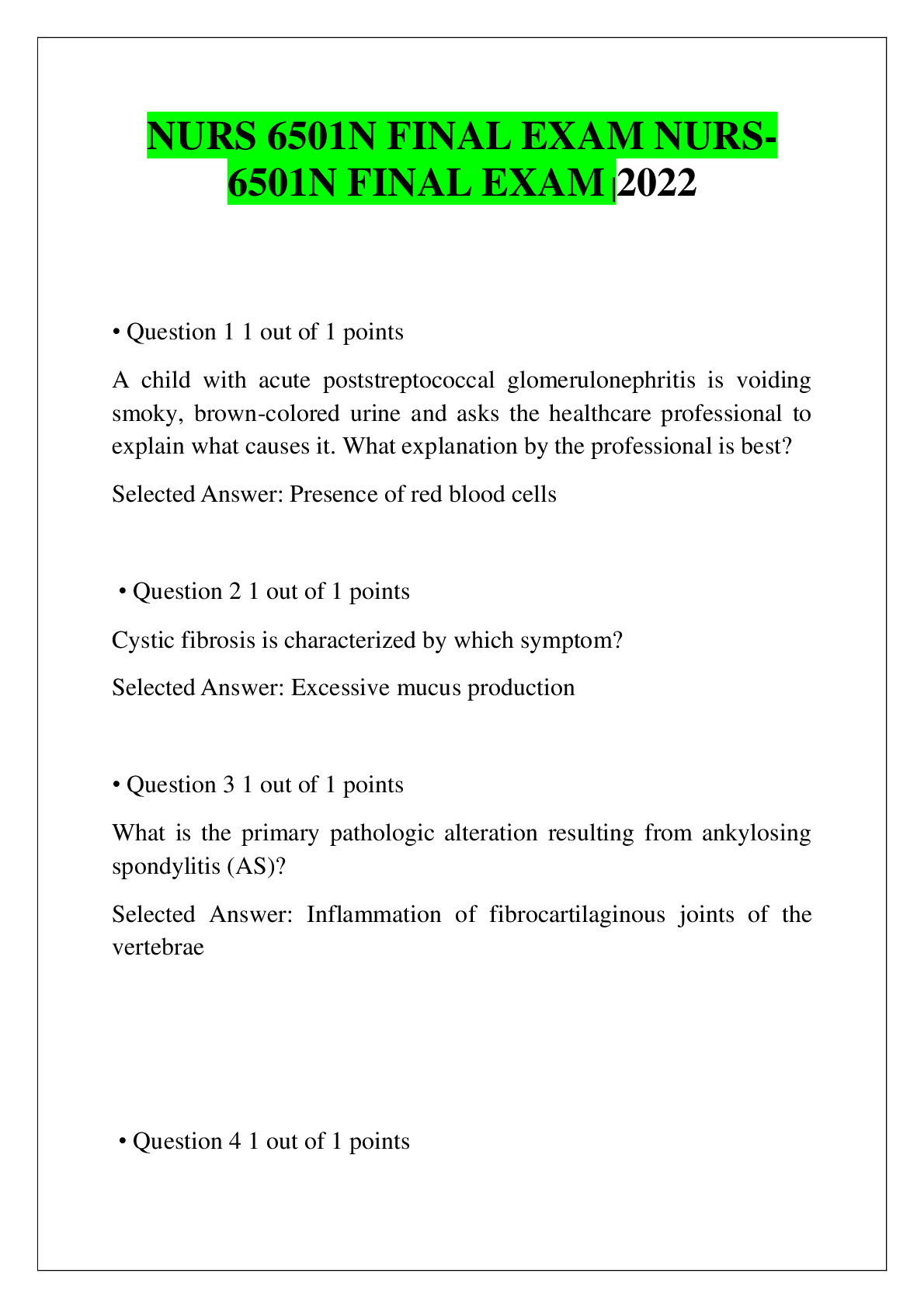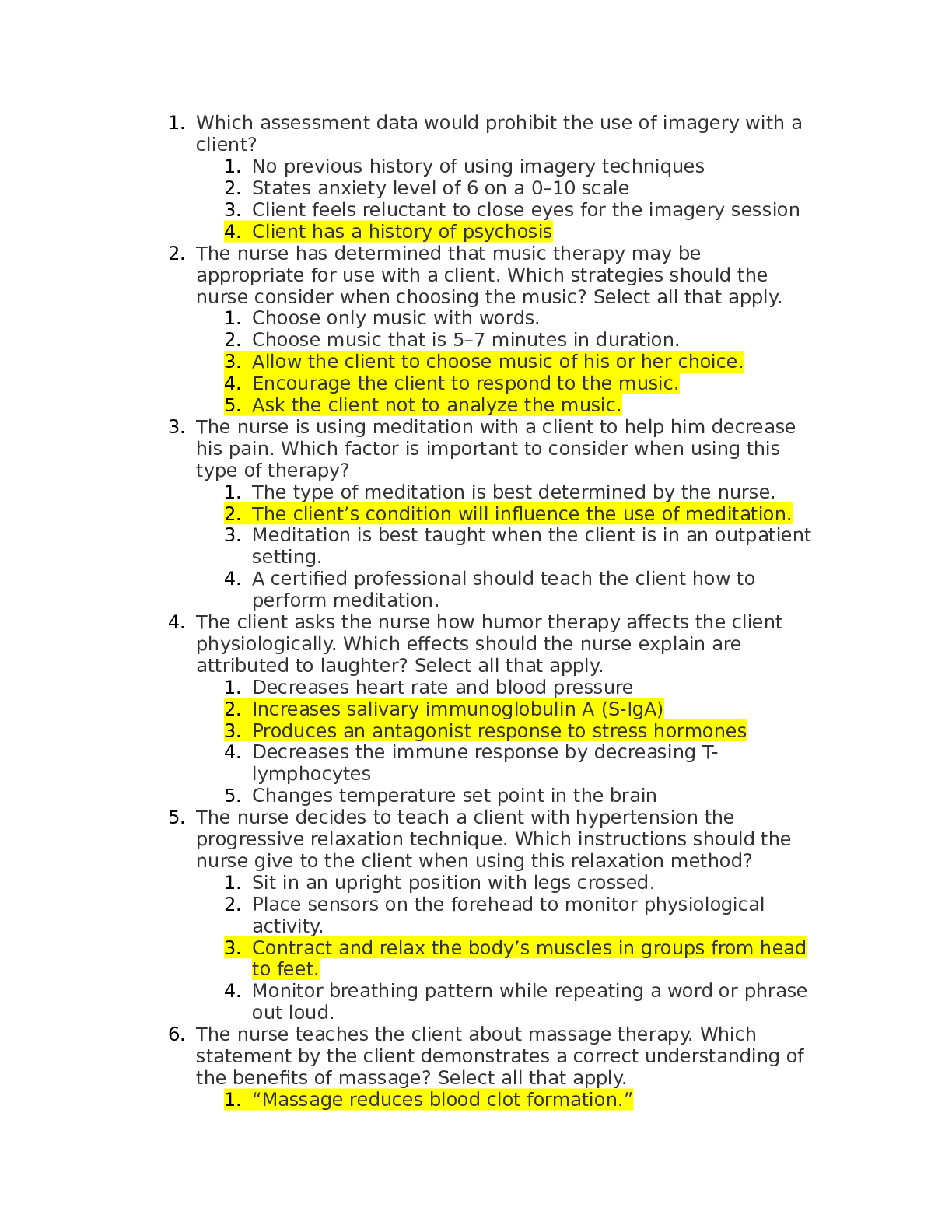Physiology > QUESTIONS & ANSWERS > PSY 101 Exam 3 all complete possible questions with answers solution updated 2020 (All)
PSY 101 Exam 3 all complete possible questions with answers solution updated 2020
Document Content and Description Below
PSY 101 Exam 3 all complete possible questions with answers solution updated 2020 CHAPTER 11: Q: About the same time that infants begin to crawl, usually between 6 and 8 months, they also begin to ... show separation anxiety. This indicates that they ____. Q: The complete cessation of a woman’s menstrual cycles is called ____. Q: Eduardo’s father, a heavy smoker, died fairly young from lung cancer. Eduardo looks at his small children and wants to lead a long and healthy life. What should be his focus? Q: Babies can’t talk. Which of the following are ways in which researchers directly assess the sensory capacities of very young babies? Q: The major theme of physical and cognitive development in midlife is ____. Q: Which of the following best describes the relationships of older adults? . Q: According to research (Fox, Hershberger, & Bouchard, 1996), who is most likely to reach milestones in motor development at the same time? Q: During pregnancy, which organ provides the developing fetus with nutrients and oxygen, and protects it from exposure to a variety of toxins and disease-causing agents? Q: Professor Edokpa teaches college classes in an evening program, and has students of all ages. Tonight they are discussing whether human rights are universal or vary according to cultural values. One student, Harry, clearly enjoys debating the pros and cons of each position, while another student, Carl, expresses frustration that he can’t figure out the correct answer. Harry is engaging in ____. A: postformal thought Q: A period of physical changes leading to sexual maturity is called ____. Q: Parenting styles can be divided into four categories, which vary along ____ (Baumrind, 1975; Maccoby & Martin, 1983). Q: Newborns show an innate preference for looking at faces. This preference ____. Q: Which of the following is in the category of the most common and preventable sources of adverse effects in the developing fetus? Q: Children grow up and move out, leaving their parents at midlife with an “empty nest.” Michael’s parents, Americans, are quite cheerful about it. Rumi’s parents, from India and now living in Canada, are quite disappointed. This difference in reaction most likely reflects ____. Q: Teens begin to form an identity by asking “Who am I?” and “What kind of person do I want to be?” According to Erikson, failure to achieve a stable identity leads to ____. Q: Gabriel is 25 years old, 6 foot 3 inches, and 185 pounds. He is an accomplished lacrosse player and continues to play in a competitive league. Gabriel ____. Q: Jack was a very timid child, both physically and socially. His parents gently encouraged him to participate in activities with other children. Over time he became quite adept at playing team sports. This is an example of ____. Q: Which of the following types of intelligence is most likely to change due to aging? Q: Which of the following is a finding from Harry Harlow’s study (1958) of rhesus monkeys and attachment? Q: The study of human development considers changes in behavior ____. Q: Long-term marriage partners show more similarities with each other due to a lifetime spent in each other’s company, along with a(n) ____. Q: The emotional bonding between an infant and a parent or caregiver is called ____. Q: How can adolescence best be described? Q: We produce many more synapses than we need, and then retain only those that are used in a “use it or lose it” fashion. What does this demonstrate? Q: The starting point of late adulthood is best described as ____. Q: Marjorie is in her seventh month of pregnancy with her first child. Which of the following is true regarding her fetus’s development? Q: Myelination of the frontal lobes is much greater in adults aged 23 to 30 than in youth between the ages of 12 and 16. Unfortunately, the adolescent’s white matter is more susceptible than an adult’s to damage from ____. Q: Which scenario exemplifies a key factor in predicting the timing of attachment? Q: Midlife is most often a time of ____. Q: Why does a 40-year-old woman have a greater probability of giving birth to a child with Down syndrome than a 25-year-old woman? Q: Sofia was six pounds at birth. She is a healthy baby. How much does she likely weigh now that she is one year old? Q: Ryan grew up in a family of four boys. He and his brothers have never engaged in “acting out” behaviors, such as excessive drinking or drug use. However, now in their teens, they tend to be depressed and withdrawn from their peers. Their parents are most likely ____. Q: Which scenario best exemplifies an ecological approach to development? Q: Kohlberg’s postconventional reasoning has been criticized as not representing a universal stage of moral development, but rather being ____ (Murphy, Gilligan, & Puka, 1994). Q: Individual differences in temperament may emerge early in life (Thomas & Chess, 1977, 1989). These traits ____. Q: Alexa is 15 years old. She is very involved in environmental issues, including issues such as the finding alternatives to fossil fuels and the protection of biodiversity on the planet. According to Piaget, Alexa is in the ____ of cognitive development. Q: With regard to developmental outcomes, your text emphasizes ____. Q: What is the definition of accommodation? Q: Ava is almost one month old. What does she spend most of her day doing? A: sleeping Q: In Erikson’s work (Erikson, 1968), a consistent, unified sense of self is called ____. Q: Marcus is about 1-1/2 years old. His mother left him at a friend’s house to play for the first time while she took the family car in for maintenance. Marcus did not show distress when his mother left nor did he immediately approach her when she returned. What pattern of attachment is this? Q: The ectoderm develops into ____. Q: Joshua is three years old. He often whines, and constantly demands attention from his parents, not venturing far from them at the park. Which of the following would most likely describe the parenting style of Joshua’s parents? Q: The obvious evolutionary purpose of puberty is to prepare an individual for ____. Q: During which stage do cells begin to differentiate into three types: the ectoderm, mesoderm, and endoderm? Q: Which of the following is true regarding young adulthood? Q: In whose life have epigenetic processes likely played the most dominant role? Q: What role does habituation play in evaluating a baby’s sensory capacities? Q: At the onset of puberty, ____. Q: A pattern of infant-caregiver bonding in which children explore confidently and return to the parent or caregiver for reassurance is called ____. Q: A failure to develop a typical theory of mind has been linked to the development of ____ (Gopnik, Capps, & Meltzoff, 2000). Q: Jenna is a very rebellious teenager. Just about everything she says and does worries her parents. Her values are most likely ____. Q: Ethan is just two weeks old. His mother strokes his cheek and he turns toward the touch and opens his mouth. This is called the ____. Q: What is egocentrism in Piaget’s view? Q: Which of the following is a criticism of Piaget’s theories? . Q: Amy loves to eat swordfish in any preparation but decides to avoid it during her pregnancy. Why? Q: The vast majority of genetic abnormalities in an embryo will result in ____. Q: The parenting style that combines high behavioral regulation with low support is ____. Q: What is a teratogen? Q: According to an influential model of relationships, the persistence of a relationship is a direct result of the partners’ commitment, which in turn is determined by the partners’ satisfaction with the relationship, the amount of investment they have already put into their relationship, and ____ (Rusbult, Martz, & Agnew, 1998). Q: Contemporary views on human development focus on age-related changes that occur ____. Q: Lucas is in first grade and works hard to print his alphabet letters on the lines on his notebook paper. In which direction is this motor development proceeding? Q: When Zach started elementary school, he was able to focus very attentively on class projects, but only for limited periods of time. By about sixth grade, his attention span started to lengthen significantly each year. Which model or theory does this exemplify? Q: To which of the following tastes will a newborn react most favorably? Q: Rachel is in junior high school. Her father drinks heavily and is frequently out of work. Her mother is very depressed and spends much of the day in front of the TV. Rachel spends as much time as she can outside of their home. Her parents’ style of parenting is ____. Q: In which of the following two scenarios does Grace demonstrate that she has developed theory of mind? ________________________________________ CHAPTER 12: Q: Leanne’s father dreads it when her mother invites Leanne’s friends over for cocktail parties and cookouts. He is reserved, uncomfortable with people he does not know well, and prefers quiet evenings of reading. The Big Five trait that best describes this aspect of his personality is ____. Q: Aiden has always been a bit shy and self-doubting. He tries to start a conversation with the attractive young woman sitting next to him in the physics lecture hall, but she turns the other way and talks only with her friend. Which of the following thoughts is most likely to be running through Aiden's mind? Q: Jim is on a diet. At his office, his co-workers often bring in donuts, cookies, and other snacks for the group. He has done fairly well in resisting the temptations each day. How does he likely feel by late afternoon? Q: Melinda’s psychology professor told the class to quickly write down five things that complete a sentence that starts with “I am.” Melinda wrote: “I am a sophomore at University of Michigan majoring in international relations. I am on the lacrosse team and continue to be in a relationship with my high school boyfriend.” This is a description of her ____. Q: The critical finding of the Minnesota Study of Twins Reared Apart (Bouchard, 1994; Bouchard, Lykken, McGue, Segal, & Tellegen, 1990) was that identical twins raised apart and together ____. Q: According to Walter Mischel (Mischel, 2004), if a child experiences a particular situation, he or she will then respond with a unique, stable set of behaviors. These if-then patterns will be characteristic of an individual, leading to the stable characteristics we think of as ____. Q: The self does not exist in a vacuum. It both shapes and is shaped by ____. Q: In Freud’s personality theory, the self that others see is called the ____. Q: Ian is a very serious and capable medical student. At home with his mother, though, he becomes a joyous boy again, telling her stories about his classes and professors and making her laugh. This implies that the interpersonal self is ____. Q: Michael grew up in an individualistic culture. He is most likely to ____. Q: Rima has decided to eliminate all sweets from her diet in an effort to lose ten pounds. When out for coffee with her friend Beth, Beth orders a delicious piece of chocolate cake with chocolate frosting and offers to split it with Rima. Rima says “Well, maybe this one time; I’ve read that chocolate is good for your health.” This is an example of ____. Q: One of the most frequently used personality inventories is the Minnesota Multiphasic Personality Inventory, which was originally designed ____. Q: Of the following, who most reflects self-efficacy? Q: The cognitive organization that helps us think about the self and process self-relevant information is ____. Q: Of the following, who illustrates one key contribution that Alfred Adler made to psychodynamic thought? Q: Where in the brain does self-referential processing -- the processing of information relevant to ourselves but not others -- occur? Q: Rosa is three years old and very exuberant. Her mother has little patience with her and is most acceptant of her when she plays very quietly by herself. According to Carl Rogers’s humanistic theory of personality, what is the most likely result of this upbringing? Q: Which qualities best describe collectivism? Q: As Erin walks to the front of the classroom to write on the board, she stubs the toe of her shoe on the floor and nearly trips in front of her professor. She is so embarrassed. However, her professor is actually thinking about his lunch plans. Erin’s reaction is an example of ____. Q: According to Freud, what is the resolution of the Oedipus complex?: Identification Q: Dominic is memorizing vocabulary for his psychology exam, including the term “allele.” Which of the following approaches will most help him remember this term? Q: Which of the following is an advantage of personality inventories? . Q: The text notes that Professor Jennifer Mather tested 44 octopuses systematically for their responses to stimuli such as being touched with a brush. What did she find? Q: To avoid the pitfalls of observation and interview, many psychologists turn to ____. Q: Joseph received a C- on two algebra exams in a row. The principal’s office automatically sent him a standard, encouraging email intended to boost the self-esteem of any student who does poorly on two assignments in a row in any subject. According to a research study described in the text, what is the most likely consequence of the email? Q: The stages in Freud's theory of the developing personality are called ____. Q: Sigmund Freud’s treatment approach based on his psychodynamic theory is called ____. Q: In Freudian theory, projection is ____. Q: Elena's brother was diagnosed with schizophrenia when he was in his twenties. Sometimes he reports that his neighbors are trying to control his behavior through the television set. Which part of the brain shows excess activity during such delusions of control? Q: Genetics account for a percentage of the variability seen in the population's personality. What is the source of the remaining percentage of variability? Q: Heather's mother maintains an orderly household. Heather's bedroom at home is very neat, with a place for everything and everything in its place. At her room at college, however, the floor is barely visible underneath the clothing, books, papers, and tea cups. According to B.F. Skinner, this most likely reflects a(n) ____. Q: Which toddler is likely to have the highest self-esteem when reaching first grade? Q: Personality tests are widely used by therapists, potential employers, judges, and attorneys. These applications of personality assessment ____. Q: The humanists are most interested in ____. Q: Lia grew up in a collectivistic culture and is in the yearly high school theatre production. She is most likely to ____. Q: Larry has put off studying for his Medieval Literature class all semester and worries that he will not do well on the final exam. He starts to drink beers and watch sports on TV each night with his roommates. This is an example of ____. Q: Which of the following best describes the attitude of most psychologists today toward Freud? Q: Autobiographical and episodic memories are important components of self-knowledge; however, as one psychologist noted, “The past is remembered as if it were a drama in which ____ (Greenwald, 1980, p. 604).” Q: In current psychological discussions of the self, influences on the interpersonal self fall into two categories: ____. Q: What is the cognitive expectancy featured in social-cognitive learning theories of personality about the source of individual outcomes? Q: What are the two basic requirements of a good test? Q: One’s knowledge of personal traits, feelings, roles, and memories is called ____. Q: Big Five theory is a trait theory that identifies five main characteristics that account for ____. Q: For Freud, what leads to the emergence of personality characteristics? Q: What is the part of mental activity that cannot be voluntarily retrieved? Q: Research showing that situations can exert a stronger influence on people’s behavior than any individual predispositions highlights ____. Q: Mary rarely refers to her strengths or accomplishments when with friends, so they have little clue as to her self-esteem. If Mary is among the majority of people, she most likely ____. Q: Sigmund Freud’s treatment approach based on his psychodynamic theory is called ____. Q: Which of the following is a common feature of neo-Freudian theories? Q: Jared, a high school student, is a sensitive person. His first reaction to many things is anxiety, such as the loud noise of a truck backfiring, an unfamiliar dog running towards him, or a teacher unexpectedly calling on him in class. Towards which end of the continuum of these Big Five traits would he likely fall? Q: What are the two dimensions of temperament that appear to be particularly important for adult personality? Q: A projective personality test provides an ambiguous stimulus onto which the test taker “projects” his or her personality. This is based on ____. Q: Olivia has just obtained her driver’s license. She is nervous that she might break one of numerous “rules of the road” and receive both a ticket and a reprimand from her parents. Which component of Freud’s personality theory does this reflect? Q: Jeremy is an Asian American. Kevin is a White American. They are high school classmates and members of the basketball team. On one of the many standardized tests they have taken, Kevin received a higher score on explicit measures of self-esteem, but on implicit measures of self-esteem, their scores were virtually identical. What is a likely reason? Q: Research showing that situations can exert a stronger influence on people’s behavior than any individual predispositions highlights ____. Q: For the past few months, Seth has visited his elderly grandmother every weekend and helps her with chores and errands. He has come to think of himself as a person who is kind and helpful to elders. As a source of self-knowledge, this is an example of ____. Q: Which of the following Big Five traits had the greatest positive correlation with success across a wide range of professional, skilled, and unskilled job descriptions? Q: The stages in Freud's theory of the developing personality are called ____. Q: Emma is nine years old and wants to know the “rules” for everything, such as card games, how to set the table, and basketball. Which developmental stage is she in? Q: The theorists who attempted to update and modify Freud’s original theory of personality are called ____. Q: Karen Horney rejected many of Freud’s ideas to concentrate on aspects of the culture that contributed to ____. Q: According to your text, what does the science of personality explore? Q: Which person is most likely to provide constructive criticism within a group? Q: Based on a meta-analysis of 88 studies (Jost, Glaser, Kruglanski, & Sulloway, 2003), which of the following combinations of traits describes a political conservative? Q: What is the social-cognitive learning theory of personality that features the mutual influence of the person and situation on each other? Q: Gia and Carmen are studying together. They take turns explaining concepts and definitions to each other because they know that recitation is a very effective memory strategy. Gia recites the definition of personality inventory: “A personality inventory is a subjective test, often using numbered scales or multiple choice, used to assess personality.” Which part of her definition is in error? Q: What “self” do we play in the presence of other people? Q: For as long as he can remember, Randy’s passion in life has been to eat, drink, and be merry. Which component of Freud’s personality theory does this reflect? Q: The humanists are most interested in ____. Q: Susan was so angry at her boss that, when she got home from work, she yelled at her husband in response to his question “How was your day?”. This is an example of ____. Q: Aaron, a pre-med student, received a C on his biochemistry exam. He told his roommate that he had studied for the exam, and that it was just bad luck that the professor had asked so many questions that he did not understand. Aaron appears to have ____. ________________________________________ CHAPTER 13: Q: Rebecca was always very close to her Aunt Rose. During her aunt’s final stage of illness, she helped her as much as she could. Their relationship could best be described as ____.A: companionate love Q: What are the three dimensions of close relationships according to Sternberg’s model? Q: Raising awareness of a negative stereotype about a group to which we belong has the ability to reduce our performance, a phenomenon known as ____. Q: During the economic downturn, Alejandro’s neighbor, a successful accountant, lost his job and had to sell his house. Alejandro decided that this neighbor “must have really messed up at his workplace.” This is an example of ____. Q: A simplified set of traits associated with membership in a group or category is called ____. Q: Which of the following leads individuals to take a more extreme position following a group discussion? Q: Children and youth are exposed to increasingly violent and graphic images and ideas through films, video games, and music lyrics. Some research results show correlations between media exposure and aggression, which indicates that ____. Q: What causes us to view person’s behavior as the result of his or her disposition, even when the behavior can be completely explained by strong situational factors? Q: Which of the following examples does not fit an evolutionary model to account for altruistic behavior? Q: In Koscik and Tranel’s study regarding the Trust Game (Koscik & Tranel, 2011), the participants most likely to increase the amount of money they gave a partner when the partner had decreased or not changed his contribution were those ____. Q: People tend to choose friends and romantic partners ____. Q: There is a natural tendency to comply in response to perceiving a social tie with another person due to powerful norms of ____. Q: Jessica, Zach, and their dog Max have been together for twelve years. Their friends joke that they all look alike. Jessica and Zach are both very attractive with dark hair and dark eyes. This similarity is known as ____. Q: What is the uncomfortable state that occurs when behavior and attitudes do not match? Q: Complying with a request from an authority figure is called ____. Q: A murder would be described as having a situational rather than a dispositional basis in which country? Q: Why might being a cooperator provide a survival advantage? Q: Which of the following most contributes to the formidability of human beings as a species? Q: Selena, a research scientist, is developing a study of prejudice. Which of the following would be most useful as an implicit measure of prejudice? Q: Danny’s soccer teammates want to play a prank on a rival team before their game. Danny is reluctant to participate, but does not want to be the only one who expresses disapproval of the plan. He goes along with the group. This scenario illustrates that conformity ____. Q: What is the definition of conformity? Q: The biological and evolutionary processes that are involved with in-group/out-group differentiation ____. Q: Which of the following reflects a problem that results from the self-serving bias? Q: In a study (Eberhardt, Davies, Purdie-Vaughns, & Johnson, 2006), participants rated stereotypical “Black features” in photographs and predicted the men’s likelihood of being sentenced for murder based on these features. What sentence was most prevalent as the ratings of stereotypical “Black” features increased? Q: In which of the following situations is Molly more likely to comply with the request of Valeria, whom she is meeting for the first time? Q: Jimmy is six years old. His parents have always yelled at him when angry but they have never hit him. They do yell at and slap each other. Based on Albert Bandura’s and other studies, what is Jimmy likely to learn? Q: For which of the following groups do testosterone levels correlate with the violent nature of the crimes for which they were sentenced, as well as the dominance and violence they demonstrated while in prison? Q: The Elaboration Likelihood Model predicts responses to persuasive messages by distinguishing between ____. Q: Rules for behavior in social settings, which are usually unwritten or unspoken, are called ____. Q: For an individual or small group to influence a larger group, it is important to ____. Q: Across many cultures, men prefer female figures in which the circumference of the waist is about 70% of the circumference of the hips, which also predicts ____. Q: Lucia has always been what some researchers call a cooperator, that is, someone who gives freely of her time, her money, and so forth, usually irrespective of the behavior of others. Cooperators, though small in number in society, are very important because ____. Q: Agreeing to a request from a person with no perceived authority is called ____. Q: Which of the following is a quality of groups where groupthink may take place? Q: Regarding infidelity in a relationship, women are most distressed by a partner ____. Q: Consider the prisoner’s dilemma (Poundstone, 1992). In which of the following pairings would the participants likely cooperate the least? A: One participant from China and one participant from the United States Q: Sandra and Derek have always had some friction in their relationship. Early on, they called it passion. After twelve years of marriage, it seems that their negative interactions now exceed their positive ones. What does this suggest? Q: Luke and Laura both come from families where their parents divorced when they were very young. They would like their marriage to last, so they try to share household and childcare responsibilities and provide each other with some time to pursue individual interests or relax. Their relationship could be described as ____. Q: Vanessa’s father was an auto mechanic. She spent countless hours as a child by her dad’s side, learning the ins and outs of his trade. There is no doubt that Vanessa is very competent in this field; however, she has applied to over fifty auto repair shops in her town and has not received one interview. Which of the following terms describes the most likely reason for this? Q: Jeremy and Bianca have been married for many years. They enjoy traveling to places in which they can explore the landscape by hiking, canoeing, etc. What factor best explains why this activity has helped maintain their relationship over time? A: engaging in novel and exciting activities Q: Grace is serving on a jury for the first time. She entered the jury room with a dollar amount in mind for damages but, following deliberations, she agreed to a significantly higher number. This is an example of ____. Q: What was a later critique or explanation of the events of the Stanford Prison Study? Q: Deborah has always wanted to go to college at Stanford. She applied but was not accepted to Stanford; however, she was accepted at U.C. Berkeley. At first, she was crushed, but then, she started telling all her teachers and friends that “U.C. Berkeley is a far more interesting school.” Her statement reflects ____. Q: Alex is generally a reasonable person -- unless he becomes very drunk. Then, he is quick to anger at his wife, accuses her unfairly of infidelity, and has on occasion tried to hit her. What role does alcohol play in these instances? Q: Mary and her husband made a great deal of money recently through the sale of their business, though they come from families of little education or money. They moved to a beautiful new home in a neighborhood well-known for the wealth and high social status of its residents. The neighbors have been very unfriendly to them. This is an example of ____. Q: Which speaker is likely to be viewed as the most credible? Q: How does your text define prejudice? Q: Since his divorce, Rodney has become increasingly cut off from his family, friends, and co-workers. Assuming his doctor is well-informed of the literature in this area (House, Landis, & Umberson, 1988; Trout, 1980), which of the following statements is he most likely to make? Q: The percentage of the human population lost to war today has decreased since the time of the hunter-gatherers. One possible reason is that between-group violence has been reduced by ____. Q: The assumption that good things happen to good people and bad things happen to bad people is called a(n) ____. Q: Which of the following is true regarding how men and women evaluate potential partners? A: Men and women do not differ on the emphasis they place on physical attractiveness, earning prospects, or personability. Q: Which of the following is most accurate of stereotypes? Q: Which of the following modifications to Milgram’s study design (1963) reduced the rate of obedience? Q: People are likely to use faces to form impressions. According to research (Rule et al., 2010), our abilities to shape accurate first impressions based on facial features ____. Q: After graduating from law school, Kayla failed the bar exam the first time around, but received the job offer she wanted. Her classmates passed the bar exam, but many remained unemployed six months later. Kayla viewed her job offer as a fluke, but felt that the failure on the bar exam accurately reflected her true abilities. According to Seligman, et al. (1979), Kayla likely suffers from ____. Q: Which of the following is accurate regarding individualistic and collectivistic cultures? Q: A positive or negative evaluation that predisposes behavior toward an object, person, or situation is called a(n) ____. Q: What is the dominant factor in romantic attraction? Q: Julio’s term paper is due on Thursday at 5 P.M. On Wednesday, he asks his professor if he can turn it in on Friday morning, to which his professor agrees. On Thursday afternoon, he asks his professor if he can hand the paper in on Monday morning. What persuasive technique does this most resemble? Q: A change in attitudes in response to information provided by another person is called ____. Q: According to initial research regarding online communications (Lee, Park, Lee, & Cameron, 2010), how are user-generated materials, such as blogs and reviews, viewed in comparison to formal news reports prepared by professional journalists? . Q: Human twin and adoption studies imply that aggressive tendencies in human beings are ____. Q: Performance of which activities are most likely to improve in front of an audience? Q: What does the term “mere exposure effect” mean? Q: What might be a purpose of the mere exposure effect from an evolutionary perspective? Q: Which of the following is true regarding physical attraction? Q: Rina enters the cafeteria of her new high school, unsure of where to sit for lunch. She approaches two groups of girls, but each group turns their backs on her to talk and laugh with each other. The pattern of her brain activity caused by the distress of social exclusion is most similar to the brain activity associated with ____. Q: Recognizing and reacting to individuals based on group affiliation was probably a very important skill for early hunter-gatherers, whose survival often depended on quickly identifying others as potential friends or foes. This categorization was made primarily on the basis of ____. ________________________________________ CHAPTER 14: Q: Jake, a veteran of the Iraq war, saw his friends be severely injured or killed on two tours of duty. He came home physically healthy but suffering from PTSD. Jake was not much of a drinker before he went to Iraq, but now, he frequently drinks alone at night. To what might this be related? Q: What is an obsession? Q: Most children with autism have a ____ level of auditory filtering than a group of typical, healthy children. Q: A dissociative disorder is characterized by disruptions in a person’s ____. Q: Alejandra, a resident of lower Manhattan, suffers from PTSD after witnessing the attack on the twin towers of the World Trade Center on September 11, 2001. A certain acrid burning smell can trigger intense feelings of jitteriness and distress for her. This is an example of ____. Q: Twin studies have found concordance rates of 63% to 87% between identical twins for obsessive-compulsive disorder (OCD). What does this suggest? Q: The lifetime risk of developing schizophrenia for a person in the general population is about 1%. For an identical twin of someone with schizophrenia, it is about ____. Q: Of the following, who is most likely to have anxiety, as opposed to fear? Q: People with panic disorder have larger quantities of orexins than people without the disorder, which may lead to panic attacks. Orexins play an important role in ____. Q: According to the DSM, the symptoms of depression in bipolar disorder are ____. Q: Dr. Moran believes that depression is purely the result of chemical imbalances of the brain and that a simple prescription should address each of his patient’s needs. This single-perspective thinking usually leads to ____. Q: A research study (Gollan et al., 2010) found that the recognition of facial expressions by people with depression followed which of the following patterns? Q: A biological bridge between the experience of stress, circadian rhythms, and the development of depression is formed by hormones released at times of stress, including ____. Q: Gabriel has become so fearful of going outside of his home alone and of being in open spaces such as parking lots that he has difficulty holding a job. This is best described as ____. Q: Which of the following is true? Q: Of the following, who is demonstrating a compulsion? Q: The weight of scientific evidence (Schechter & Grether, 2008) indicates that thimerosal, a mercury-containing preservative that has been used in vaccines, ____. Q: African immigrants living in South London were more likely to be diagnosed with schizophrenia if they lived in a predominantly White neighborhood than if they lived in a primarily non-White neighborhood (Boydell et al., 2001). According to the text, what do these findings suggest? Q: Who of the following is within the group most likely to have the lowest rate of bipolar disorder? Q: According to research (Bryan & Rudd, 2006), almost 20% of 18-to-20-year olds who had experienced at least ____ attempted suicide. Q: Which of the following is true of anxiety? Q: Social and evolutionary theories of depression and loneliness suggest that these states might promote an individual’s survival by ____. Q: Lauren has been chosen to introduce the guest speaker to her economics class. She is worried about how she will look and sound to her classmates, her palms are sweaty, and she can feel her heart beating. This is best described as ____. Q: The presence of two or more disorders in the same individual is called ____. Q: Suicide is the eleventh leading cause of death in the United States for all ages, but among young adults ages 25 to 34, it is the ____. Q: Of the following, who is demonstrating mania? Q: Which of the following scenarios is most suggestive of someone who might intend to commit suicide? Q: What is the current edition of the DSM? Q: A drawback to the purely statistical approach to abnormality is that it might result in very different definitions of psychological disorder ____. Q: Who would be exhibiting normal behavior under the statistical definition of abnormality? Q: Roy is a competitive snowboarder with a dream of being on the Olympic team someday. After a series of poor finishes and falls during competitions, he tells his parents that he was never very good, he will never make the Olympic team, and snowboarding is a stupid sport anyway. His parents worry that he is becoming depressed. This is a ____. Q: What may well-meaning therapists misinterpret as dissociative identity disorder? Q: Which of the following parents may be providing a prenatal risk factor for a child with autism? Q: Alice experienced a period of confusion as to who she was, during which she traveled from Boston to New York under the name of Agatha Christie. This is an example of ____. Q: A study looked at identical twins in which one member of each twin pair experienced combat and the other twin did not (Gilbertson et al., 2002). What did this study suggest? Q: The pediatrician tells Danny’s mother that his attention deficit hyperactivity disorder is due to delayed brain maturation. Which approach to psychological disorders does this exemplify? Q: Mira has hallucinations and delusions. Which of the following is a hallucination, as opposed to a delusion? Q: Brian has been diagnosed with bipolar disorder. One symptom he experiences during both his manic and depressive episodes is disturbance to his sleep. What links mania, depression, and sleep? Q: According to the diathesis-stress model, a psychological disorder such as depression might be caused by stress interacting with which of the following? Q: Frank knew that his elderly neighbor Madge did not believe in banks and that she kept large amounts of cash hidden in her home. Frank murdered Madge one day when he knew that she would be home alone, and stole her cash. During his trial, expert testimony was presented that Frank fit the criteria for a psychopath. It is highly likely that his crime was found to be ____. Q: Which of the following biological factors may be implicated in depression? Q: Concordance rates among identical twins for bipolar disorder are commonly reported to be ____. Q: A delusion is a(n) ____. Q: Most patients with schizophrenia demonstrate a lower level of frontal lobe activity than healthy control participants. Why would this difference be significant? Q: Mia’s doctor tells her that her depression and sleep problems are related. How would the doctor most likely explain this? Q: What is taijin kyofusho? Q: Four students in sociology class received a D on their final project and are required to re-write and re-submit it. In their response to this situation, who exemplifies the attribution style that is most prone to depression? Q: In the development of autism, environmental factors are likely to interact with genetics, especially ____. Q: As a child, Kim was always highly reactive to new situations. In addition, her mother was a worry wart, so Kim learned to view the world as a place requiring vigilance. When her father died, Kim’s doctor attributed her stress levels to general anxiety disorder (GAD). The source of her GAD is best described by using a(n) ____. Q: Which perspective suggests that phobias might be exaggerations of an otherwise useful sense of caution? Q: Professor Hall is giving a surprise test in economics class. All other things being equal, which of the following students is likely to make the most errors on the exam? Q: What is the name of the disorder characterized by an unusual lack of remorse, empathy, or regard for normal social rules and conventions? Q: The parts of the brain implicated in ADHD, such as the prefrontal cortex and the basal ganglia, feature large amounts of ____. Q: Which brain structures are thought to be involved in generalized anxiety disorder? Q: Liam is five years old and cannot sit still. He is almost always active and noisy and has difficulty maintaining sustained attention and following instructions in his kindergarten class. What condition might he have? Q: Which of the following exemplifies specific phobia? Q: Ryan is four years old. He does not like to make eye contact, does not engage in reciprocal games with his parents or other children, and does not express awareness of others’ points of view. His deficits may be due to ____. Q: Which of the following is a potential cause of attention deficit hyperactivity disorder? Q: Jacob is nine years old. He dislikes and often avoids doing things that require sustained mental effort, such as his schoolwork and homework. According to the DSM, ____. Q: Which of the following statements is true regarding attention deficit hyperactivity disorder (ADHD)? Q: Which of the following is one of the proposed reasons for the rapid increase in autism rates over the last two decades? Q: Corporate psychopaths score very high on measures of selfishness, callousness, and ____. Q: Somatoform disorder/somatic symptom disorder is characterized by physical symptoms ____. Q: Which of the following people is within a group that would have the highest chance of experiencing PTSD after witnessing the attacks on the twin towers of the World Trade Center on September 11, 2001? Q: What is borderline personality disorder? Q: What kind of obsessions are involved in obsessive-compulsive disorder? Q: When patients with a history of suicidal thoughts, but no attempts, were followed over a 10-year period, the patients that did commit suicide differed from the other patients in ____. Q: Teens typically experience a burst of cortical gray matter growth at puberty followed by a wave of gray matter loss extending into their early twenties. Teens diagnosed with schizophrenia experience ____. ________________________________________ CHAPTER 15: Q: After evaluating Bart, Dr. Aimes considers switching him from Thorazine to Clozaril, a drug that affects several neurotransmitters, including ____. Q: What is the primary downside to using learning models that emphasize anger control, social skills, and moral reasoning to treat antisocial personality disorder? Q: Barbiturates were once commonly used to treat anxiety; however, they are not ideal because they ____. Q: The discovery of which class of drugs after World War II changed the treatment of anxiety dramatically? Q: Behavioral therapies use applications of ____. Q: Rena and her therapist discuss how she feels when she goes on eating binges. Rena states that she is overwhelmed by guilt and that dieting just makes her crave food even more. Her therapist states that it must be difficult for Rena, because we live in a society where we are constantly judged by our appearance and where self-worth is often equated with willpower. What type of therapy does this scenario illustrate? Q: After several failed attempts at treating his major depressive episodes over the years, Patrick contemplates undergoing electroconvulsive therapy (ECT). He discusses this with his doctor, who warns him that ECT can lead to ____. Q: Dr. Sands thinks that he is close to discovering an effective medication for the treatment of antisocial personality disorder, but his colleague Dr. Boyer cautions that ____. Q: Although the exact mode of action of electroconvulsive therapy (ECT) is currently unknown, most patients experience an increase in responsiveness to ____. Q: Dr. McGuire specializes in the treatment of borderline personality disorder. She engages her patients in a type of therapy that addresses their symptoms in the order of their importance: reducing suicidal thoughts, reducing behaviors that interfere with therapy, and finally, reducing behaviors that interfere with the quality of life. This type of therapy is referred to as ____. Q: The medications Ritalin and Adderall, which are prescribed for the treatment of attention deficit hyperactivity disorder (ADHD), act by ____. Q: Rena’s therapist asks her a series of questions about her childhood, such as her relationship with her parents. She is asked to recall, in depth, her interactions with her parents, particularly during mealtime. The therapist tells Rena that her conflicts with her parents at dinnertime may be a source of the problem. What type of therapy does this scenario illustrate? Q: Dr. Smirnova feels that she made significant progress with her client, Alyssa, at their last session. This week, Alyssa cancels her appointment at the last minute, stating that she does not feel well. Dr. Smirnova suspects that Alyssa is showing signs of ____. Q: Alex would like to pursue an undergraduate degree in psychology, but is worried that without a graduate degree, his career choices will be limited. What information would you share with Alex to help him decide whether or not to pursue an undergraduate degree in psychology? Q: Dr. Schwartz is developing transgenic mouse models to better understand the efficacy of drugs used to treat schizophrenia. She manipulates several genes in the mice and then tests the effects of phenothiazines on the rodents. What should she measure to ensure the effectiveness of phenothiazines in her transgenic mouse models? Q: The use of medication for attention deficit hyperactivity disorder (ADHD) in the United States is how many times higher than in any other nation? Q: The most popular method for treating major depressive disorder today is ____. Q: One of the earliest examples of cognitive therapy was developed by ____. Q: Dr. Sebastian asks his client to say whatever comes to mind about his mother without attempting to censor the content. This technique is referred to as ____. Q: Person-centered therapy was developed by ____. Q: Rena’s therapist suggests that she find an alternative behavior to engage in, such as chewing a stick of gum or calling a friend, whenever she is compelled to grab a snack in-between meals. The therapist also encourages Rena to reward herself when she meets her goals. What type of therapy does this scenario illustrate? Q: Compared with Europe, how is psychotherapy regulated in the U.S.? Q: Electroconvulsive therapy (ECT) results in the induction of ____. Q: Dr. Estevez uses a behavioral approach when treating his clients. What underlying ideology influences his therapeutic style? Q: According to humanistic theories, human unhappiness results from ____. Q: Psychoanalysis falls under which class of psychological theory? Q: Rena’s therapist challenges her to think about her past dieting failures, in which Rena would strictly limit her caloric intake. She asks whether Rena’s “all-or-nothing” view of eating was rational – “Is it realistic to think that portion control should be either rigid or not worth regulating at all”? What type of therapy does this scenario illustrate? A: cognitive therapy Q: What is a major benefit of group therapy? Q: In addition to scientific evidence, what does evidence-based practice (EBP) utilize to provide the best outcome for a client? Q: What is the downside to using behavioral interventions to treat attention deficit hyperactivity disorder (ADHD)? Q: Recent medical school graduate Dr. Boykin is undertaking his psychiatry residency with Dr. Stone, an expert in repeated transcranial magnetic stimulation (rTMS). As the two doctors prepare for a clinical trial involving rTMS, Dr. Stone warns that rTMS can have negative effects on patients with a history of ____; therefore, these patients must be excluded from the study. Q: Chandra, who is interested in the field of holistic medicine, attends a conference on hypnosis. During one seminar, she learned that hypnosis originated as a treatment for ____. Q: Cognitive-behavioral therapies work best for which somatoform/somatic symptom disorder? Q: Dr. Aimes is concerned that due to the Thorazine, Bart is showing signs of ____. Q: Dr. O’Shea meets with a new patient, Doris, to discuss performing deep brain stimulation for the treatment of her severe depression. He describes the technique to Doris and explains that microelectrodes will be placed in Doris’s ____. Q: The Food and Drug Administration has approved what class of drugs for the treatment of autism? Q: Dr. Aimes notes that the Thorazine has been effective at reducing Bart’s ____. Q: Ginger worries constantly about contracting a deadly virus. Because of this, she washes her hands repeatedly throughout the day with scalding hot water. Assuming that Ginger has OCD, what type of medical health professional is most likely to take a biological approach to treatment? Q: Cognitive-behavioral therapy has an excellent record of success, particularly in the treatment of ____. Q: What is the role of psychotherapy in the treatment of bipolar disorder? Q: What is the rationale for using stimulants to treat attention deficit hyperactivity disorder (ADHD)? Q: Michaela seeks the help of a therapist for her depression, but is adamant about not wanting to take medication. Michaela’s therapist recommends an alternative approach that is thought to be just as effective as medication. What does her therapist recommend? Q: Why is it thought that SSRIs cause sexual dysfunction? Q: The evidence suggests that the earliest attempts at psychosurgery involved ____. Q: After running out of the medication that he takes to treat his bipolar disorder, Dan calls the pharmacy and asks for a refill of ____. Q: Tonya recently began a new job as a social worker at a state penitentiary. She would like to incorporate a new program to work with offenders diagnosed with antisocial personality disorder. She researches the most effective treatment options and chooses a training program that speaks to the selfish nature of individuals with this disorder, namely “____” (Salmon, 2004). Q: After deciding to switch Bart from Thorazine to Clozaril, Dr. Aimes tells Bart that she will need to meet with him again very soon to monitor a new batch of potential side effects, such as ____. A: diabetes Q: Dr. Cohen uses a humanistic approach when treating his clients. What underlying ideology influences his therapeutic style? Q: In the 1950s, Henri Laborit encouraged his psychiatric colleagues to try phenothiazines on their psychotic patients. What led him to make this suggestion? Q: What is the primary disadvantage of using computerized therapeutic tools, such as Wiley’s TheraScribe, when treating clients? Q: Dr. Zhang notices that his client, Mariel, becomes very defensive when asked to elaborate on her financial difficulties. Dr. Zhang infers that Mariel has likely been defensive with her parents and supervisors at work as well. What technique is Dr. Zhang using to make his inference? Q: Dr. DeMarco prefers to use cognitive-behavioral techniques rather than medication to treat his clients with anxiety disorders because ____. Q: Neurofeedback appears to be promising in the treatment of ____. Q: The use of stimulants to treat attention hyperactivity deficit disorder (ADHD) was discovered by Charles Bradley, who initially used the drugs to ____. Q: A non-surgical alternative to deep brain stimulation is repeated ____. Q: Dr. Maynard uses a psychoanalytical approach when treating her clients. What underlying ideology influences her therapeutic style? Q: Dr. Lopez, a psychiatrist with expertise in antidepressant medications, gives a plenary lecture entitled Antidepressants Today at the annual American Psychiatric Association conference. Assuming Dr. Lopez is in agreement with recent studies, he is likely to tell his audience that antidepressants ____. Q: Trudy takes Thorazine, a phenothiazine, as part of her treatment regimen for schizophrenia. Sometimes she does not pay close attention and accidentally takes two doses in one day. Her doctor warns her that this is very dangerous because it could produce symptoms consistent with ____. Q: Dr. Bohsle uses a cognitive approach when treating her clients. What underlying ideology influences her therapeutic style? Q: In psychoanalysis, how is the client-therapist relationship structured? Q: Dr. Vinard suspects his patient Muriel has somatization disorder and refers her to a psychotherapist. At a follow-up visit, Dr. Vinard learns that Muriel failed to schedule an appointment with the psychotherapist. According to the text, what is the most likely reason for this? Q: Genaya recently sought help for obsessive compulsive disorder after she found that she could not control her compulsion to pull out her hair. Her therapist, who uses behavioral techniques, suggested that when Genaya feels the overwhelming urge to pull out her hair, she should ____. Q: Behavior modification focuses on ____. Q: Although the American Psychological Association (APA) has the primary responsibility for accrediting Ph.D. or Psy.D. psychology degree programs, the Psychological Clinical Science Accreditation System (PCSAS) was recently formed to increase ____. Q: Dr. Blagojevich is interested in understanding how antidepressants affect brain structure. After administering SSRIs to a group of rats for several weeks, Dr. Blagojevich analyzes their brain tissue. He is likely to find an increase in ____ (Malberg, Eisch, Nestler, & Duman, 2000; Nasrallah, Hopkins, & Pixley, 2010). Q: Dr. Johnson is screening for more effective treatments for bipolar disorder. To see if these compounds work in a similar manner to the most commonly prescribed treatment, she treats rats with the derivatives for several weeks and then measures ____. Q: Who popularized the use of frontal lobotomies in the United States by performing the procedure on thousands of individuals between the 1930s and 1950s? Q: Bianca is trying to decide between pursuing a Ph.D. or Psy.D. degree in psychology. As her friend, you tell Bianca that a major critique of the Psy.D. degree is that it ____. Q: Shaunice tells her best friend Cheryl that she recently began cognitive-behavioral therapy (CBT), via online live video sessions with a therapist. Because Cheryl, a clinical psychology graduate student, is familiar with the research on this approach (Ruwaard, Lange, Schrieken, & Emmelkamp, 2011), she is likely to advise Shaunice that ____. Q: Tom is serving a 25-year prison term for armed robbery. While incarcerated, he is diagnosed with antisocial personality disorder. The prison psychiatrist prescribes barbiturates for Tom. What is the most likely reason for the psychiatrist’s decision to prescribe barbiturates? Q: Emily is studying to be a Reverend in the Episcopal Church and would also like to work as a family counselor. What type of degree would be best for Emily to pursue? Q: What is the relationship between medication and the treatment of borderline personality disorder? personality disorder. Q: While working on a term paper for her Methods in Psychology course, Angelique researches psychosurgical approaches to treating psychological disorders. She is surprised to find out that frontal lobotomies were routinely performed well into the 1960s, until ____. Q: Who is credited with being the first person to use “talking therapy?” ________________________________________ CHAPTER 16: Q: Jenna has been smoking since she was 17 years old. She is now 26. If she quits before the age of 30, ____. Q: Nutrition plays a significant part in overall physical development, including brain development, and is believed to be responsible for many differences in psychological and health outcomes ____. Q: Jeanette is having one of those days. She spilled her coffee all over her research materials for her final paper, she is running late for a meeting with her professor about the paper, and she needs to be at the airport soon for a flight to her best friend’s wedding. These events ____. Q: In the Consumer Reports survey regarding everyday safety behaviors (Consumerreports.com, 2009), in which of the following categories did participants report the highest percentage of safe behavior? Q: In the United States, how does the life expectancy of Black Americans compare to the life expectancy of White Americans? Q: Kimberly learns that each of her three best friends has a BMI of 30 or greater, which means that they are obese. She herself is overweight, with a BMI of 27, but is not obese. Which of the following is true? Q: There are many interactions among the variables of stress, sleep, nutrition, smoking, alcohol use, and exercise. Which of these behaviors are affected by our social context? Q: Research indicates that some people experiencing substantial stress enjoy good health, while others suffer from its harmful effects. How does the text suggest we reconcile these results? Q: Results from the Gallup World Poll, the first representative sample of all people on the planet, showed that social psychological “wealth” predicted ____. Q: Who appears to be in the exhaustion stage of the General Adaptation Syndrome? Q: Jack has been drinking daily for many years. He finds that over time, he has had to increase the amount he drinks to feel the same buzz. This is an example of ____. Q: The Holmes and Rahe scales have been used to predict vulnerability to physical illness and psychological disorder due to different stressors that are ____. Q: Sitting predicts risk of death independently from a person’s level of exercise. Based on the average person who sits 55% of their day, how many in that group would have died after thirteen years of follow-up? Q: Lloyd, who was watching television in his apartment late at night, heard a door creak and his heart started to pound before he even realized what was happening. What is the reason for this? Q: Positive psychology is an approach to psychology that emphasizes ____. Q: For our hunter-gatherer ancestors to survive, physical activity was essential. Today, what do children and adults in the United States spend an average of 55% of their day doing? Q: Which of the following is one of the criticisms of positive psychology? Q: Researchers found that happiness predicted bigger increases in income, while higher income did not predict increases in happiness. What was the basic explanation for the former? Q: Alcohol contributes to an enormous loss of potential years of life due to ____. Q: Which of the following is true regarding positive institutions? Q: What is the branch of psychology that investigates the relationships between psychological variables and health? Q: What does research (Luo, Zhang, Watson, & Snider, 2010) indicate is the major source of marital happiness? Q: Carson has been very stressed while pulling numerous all-nighters to complete his final exams and papers. He comes down with the flu the very next day after his last exam. What is a likely reason for his illness? Q: Wendy is an extremely competitive post-doctoral fellow in a cancer research laboratory. She works late each night and sometimes through the night. She is quick to anger at the college and graduate students assisting in the lab when she feels they are not meeting the lab’s high standards. Her personality is ____. Q: What is a stressor? Q: According to a study of over 42, 000 Americans beginning in 1972 (Davis, Smith, & Marsden, 2006), who is most likely to report being “very happy”? Q: Once the amygdala has identified a stimulus as potentially dangerous, it communicates with the ____. Q: Which of the following is true regarding biology and alcohol use? Q: What does the text suggest would be a fruitful area of emphasis when viewing schools as positive institutions in their communities? Q: What is one of the ways in which positive psychology differs from humanism? Q: Which expression best illustrates the idiosyncratic nature of stress? Q: Who foreshadowed the development of positive psychology by considering what makes some people “healthy-minded” and others to have a “sick soul” in his book, The Varieties of Religious Experience? Q: Which of the following is considered to be the leading preventable cause of death in the United States, and directly responsible for one out of five deaths each year? A: cigarette smoking Q: Ellie, a sophomore in college, is feeling very stressed about keeping up with her coursework, part-time job, extracurricular activities, social scene, and friends and family at home. What is the first step she should take? Q: Which of the following statements is true? Q: Stella, who notices that a man is walking behind her as she returns to her dormitory at night, quickly assesses the situation to determine if there might be any danger. She realizes with relief that it is someone she knows from class. She is using a(n) ____ Q: In 1948, the World Health Organization (WHO) proposed the following definition of health: “a state of complete physical, mental and social well-being ____.” Q: Which of the following is true? Q: In a study among college students (Hystad et al., 2009), the trait of hardiness ____. Q: Psychologist Gordon Allport (1964) defines “value” as “a belief ____.” Q: What is the circuit that responds to perceived stressors by initiating the release of epinephrine and norepinephrine into the bloodstream? Q: In the United States, which of the following persons is most likely to smoke? Q: What is the first stage of the General Adaptation Syndrome? Q: Viktor Frankl, a Holocaust survivor, recommends that people cope with unforeseen disasters by asking what question? Q: During the year preceding his parents’ divorce, Kevin found himself frequently arguing with his father. Now when he visits his father, Kevin tries to engage him in conversations about their favorite sports teams. This is an example of ____. Q: Which of the following rat pups were bolder (i.e., less stressed) than the others in the open field test (Francis, Diorio, Liu, & Meaney, 1999)? Q: When Lenny came face-to-face with a young bear while hiking in the Sierra Nevada mountains, sensory input traveled to his cerebral cortex and to his amygdala. In what order was the sensory input initiated? Q: When do people experience flow? Q: What is the response to stress that is possibly more characteristic of females and is associated with the release of oxytocin? Q: Who is likely to have the greatest increase in risk of heart disease? Q: What is the General Adaptation Syndrome (GAS)? Q: Who appears to be in the resistance stage of the General Adaptation Syndrome? Q: Caleb feels very discouraged upon learning that he had been cut from the varsity football team and now will play with the junior varsity. Which of the following would be the most positive emotion-focused coping response? Q: Which of the following is true? Q: Which of the following is true regarding happiness? Q: If Ethan experiences a big jolt of cortisol due to a stressor late in the evening, how will his sleep likely be affected? Q: The Adverse Childhood Experiences Study (Centers for Disease Control and Prevention, 2010b) is using an integrated model of health to address gaps in understanding about the relationships between social, emotional, and cognitive impairments and prior ____. Q: Hailey plans a family reunion at the lake and wants it to be perfect. With over fifty people attending, though, things do not go exactly according to plan and Hailey is highly stressed all day. Which of the following would most help Hailey reduce her stress levels for future events? Q: What is the common link between the lack of exercise and developing heart disease – and the lack of hand washing and developing the flu? Q: What is the second stage of the General Adaptation Syndrome? Q: Which of the following statements is true? Q: Some psychologists refer to individual differences in the ability to cope with stress as resulting from a personality trait of hardiness. Which aspect of hardiness reflects seeing the world as interesting and seeking involvement rather than withdrawal? Q: Beth, while riding her bicycle down a city street, was nearly knocked into traffic by the abrupt opening of a parked car door. What did her hypothalamic-pituitary-adrenal axis do in response to the perceived stressor? Q: Three weeks after the 2004 Indian Ocean tsunami, prevalence of PTSD among children in Sri Lanka ranged between 14% and 39% and could be predicted by variables such as family loss and severity of exposure. This finding indicates that ____. Q: Juan received a challenging health diagnosis. He responded by educating himself about his health condition and participating fully in decisions about his treatment. What major variable that predicts our response to stress does this exemplify? Q: What is one of the reasons that those who score highest on the “pleasant life,” without comparable scores on either the “good life” and/or the “meaningful life,” tend to be less happy (Seligman, 2002; Seligman & Csikszentmihalyi, 2000)? Q: Molly, a college student, has never smoked, jogs about three miles per day, and, while not a vegetarian, emphasizes fruits and vegetables in her diet. What is the fourth health habit that would help her reduce her overall risk of chronic disease by 78%? Q: Which of the following is an example of increasing happiness through living a “good life”? Q: How do humanists and positive psychologists approach the concept of “values”? Q: Which of the following best explains why people living in lower income neighborhoods often experience more stress and have higher rates of depression? Q: Blake is trying very hard to quit smoking but his friend Javier still smokes, often while they watch sports events together on the TV. Just the smell of Javier’s cigarette makes him crave a cigarette. What should he do? Q: George has gone into a deep depression after the death of his wife, for whom he had provided daily care for over two years after her first stroke. What role might cortisol play? Q: Stress is defined as an unpleasant emotional state that results from ____. [Show More]
Last updated: 1 year ago
Preview 1 out of 40 pages
Instant download

Buy this document to get the full access instantly
Instant Download Access after purchase
Add to cartInstant download
Reviews( 0 )
Document information
Connected school, study & course
About the document
Uploaded On
Nov 12, 2020
Number of pages
40
Written in
Additional information
This document has been written for:
Uploaded
Nov 12, 2020
Downloads
0
Views
284




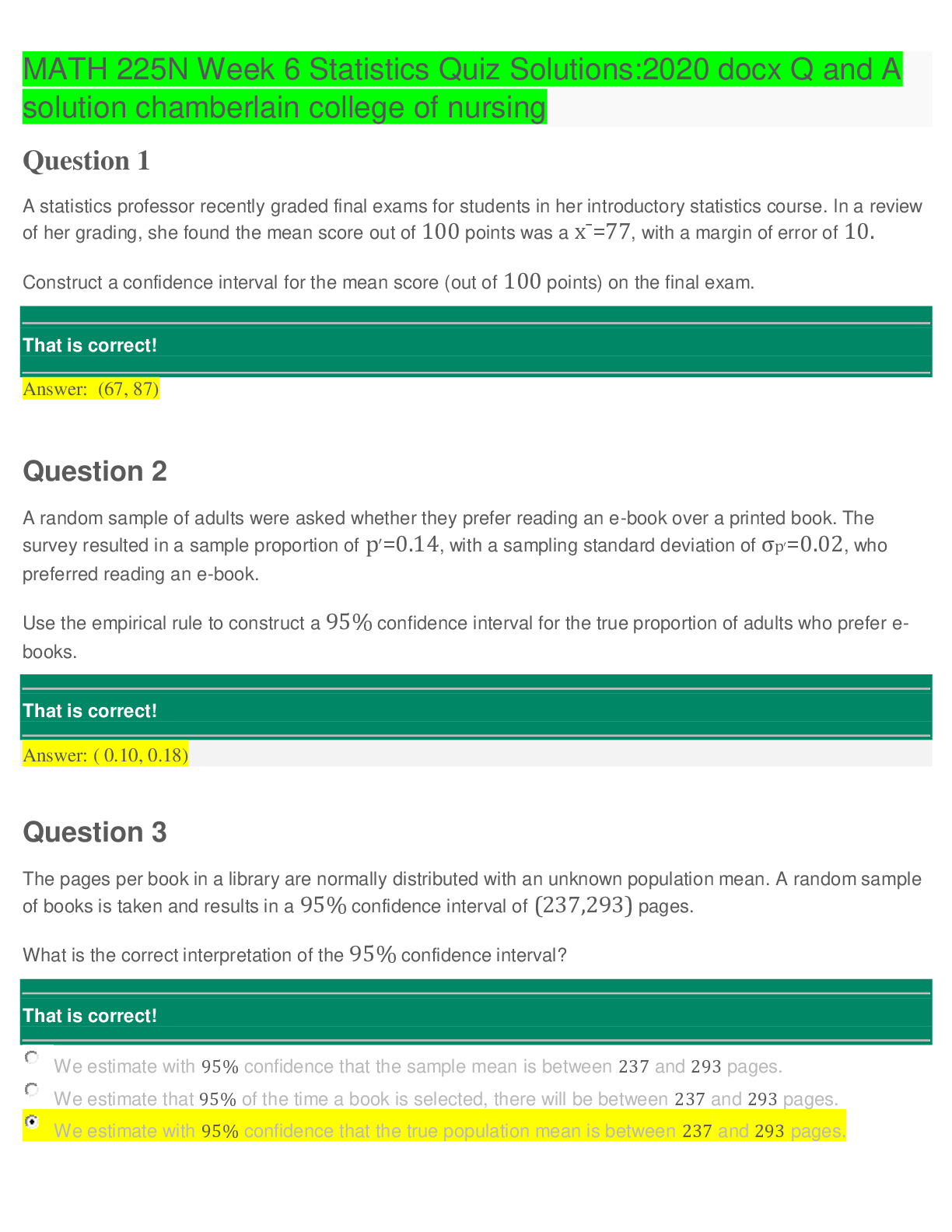

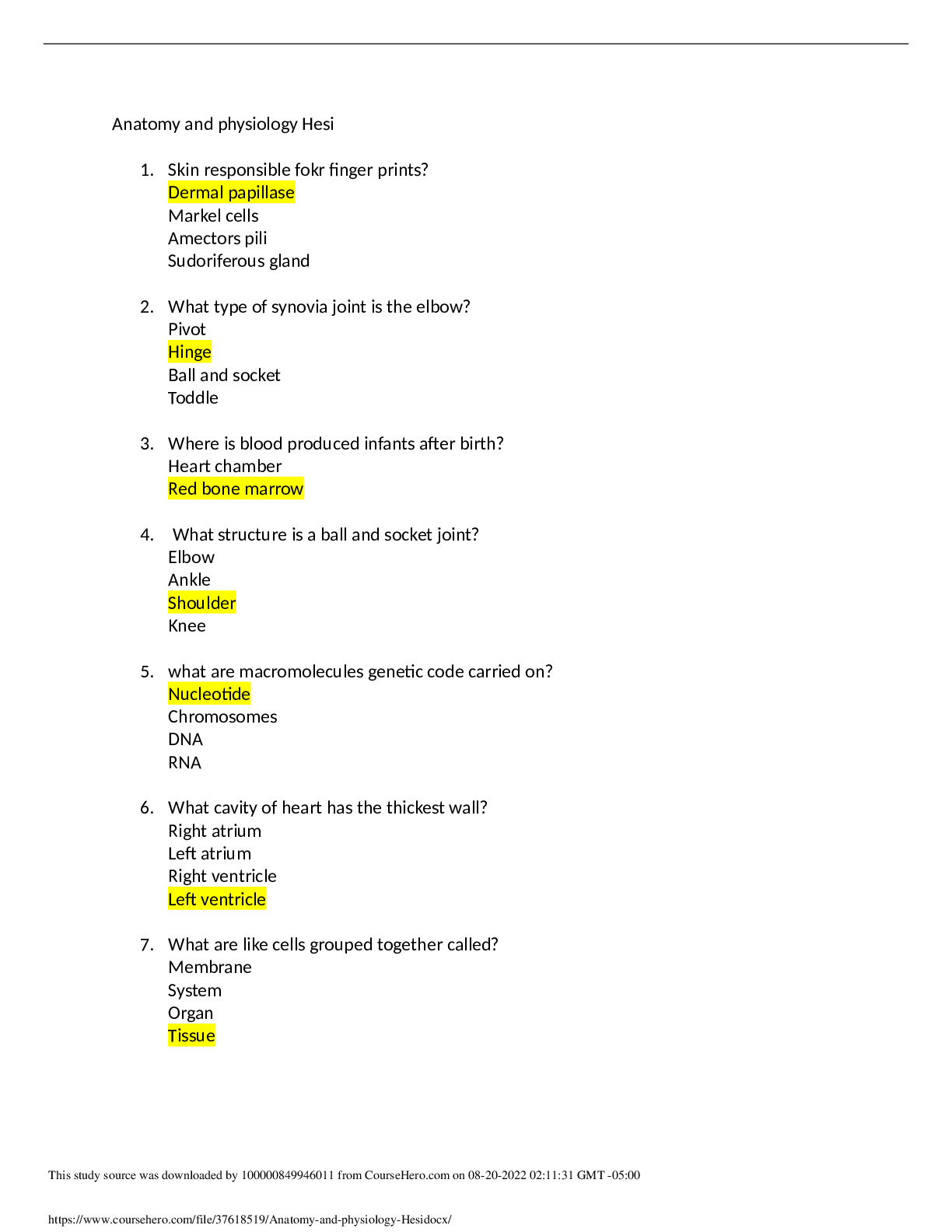
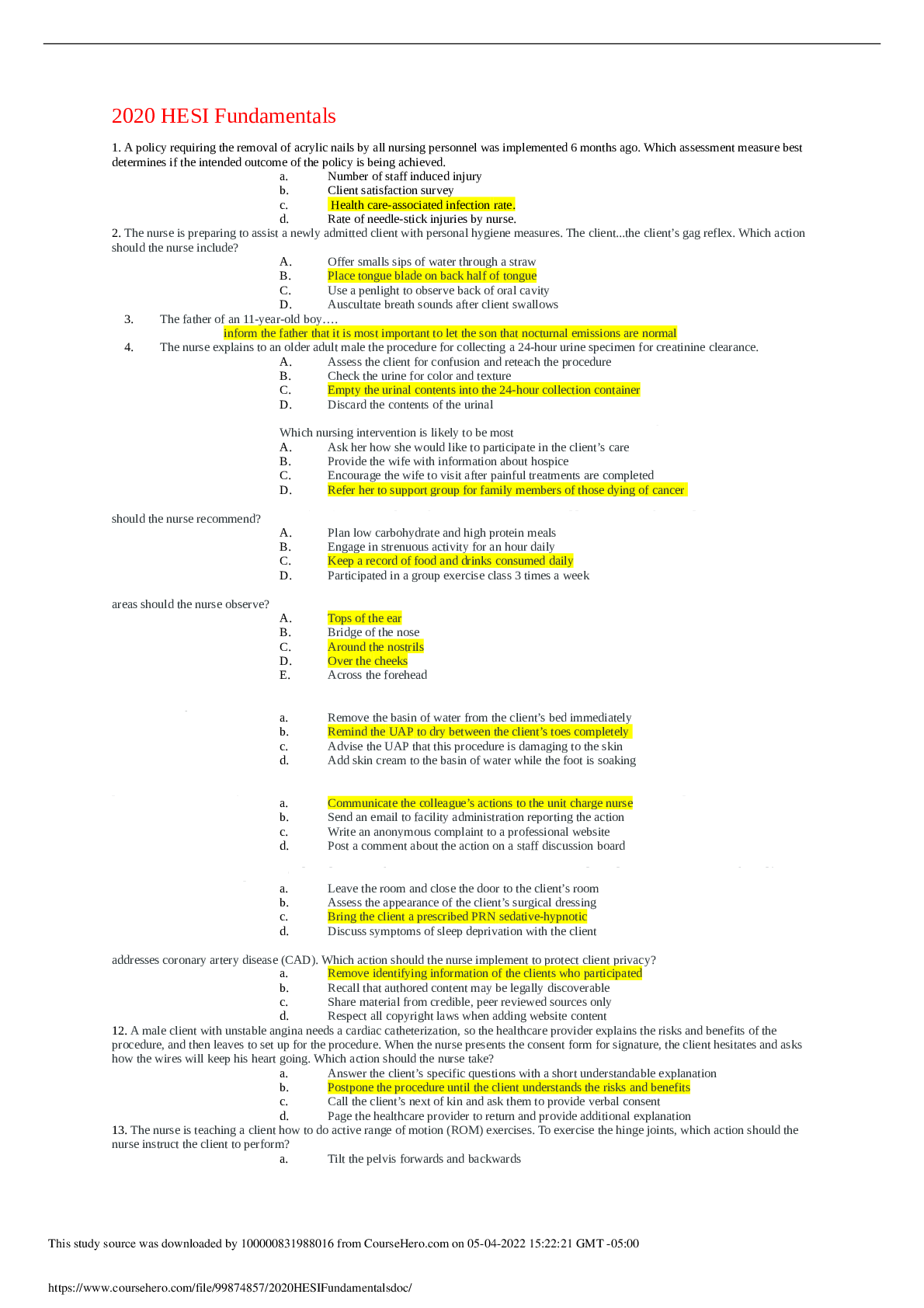

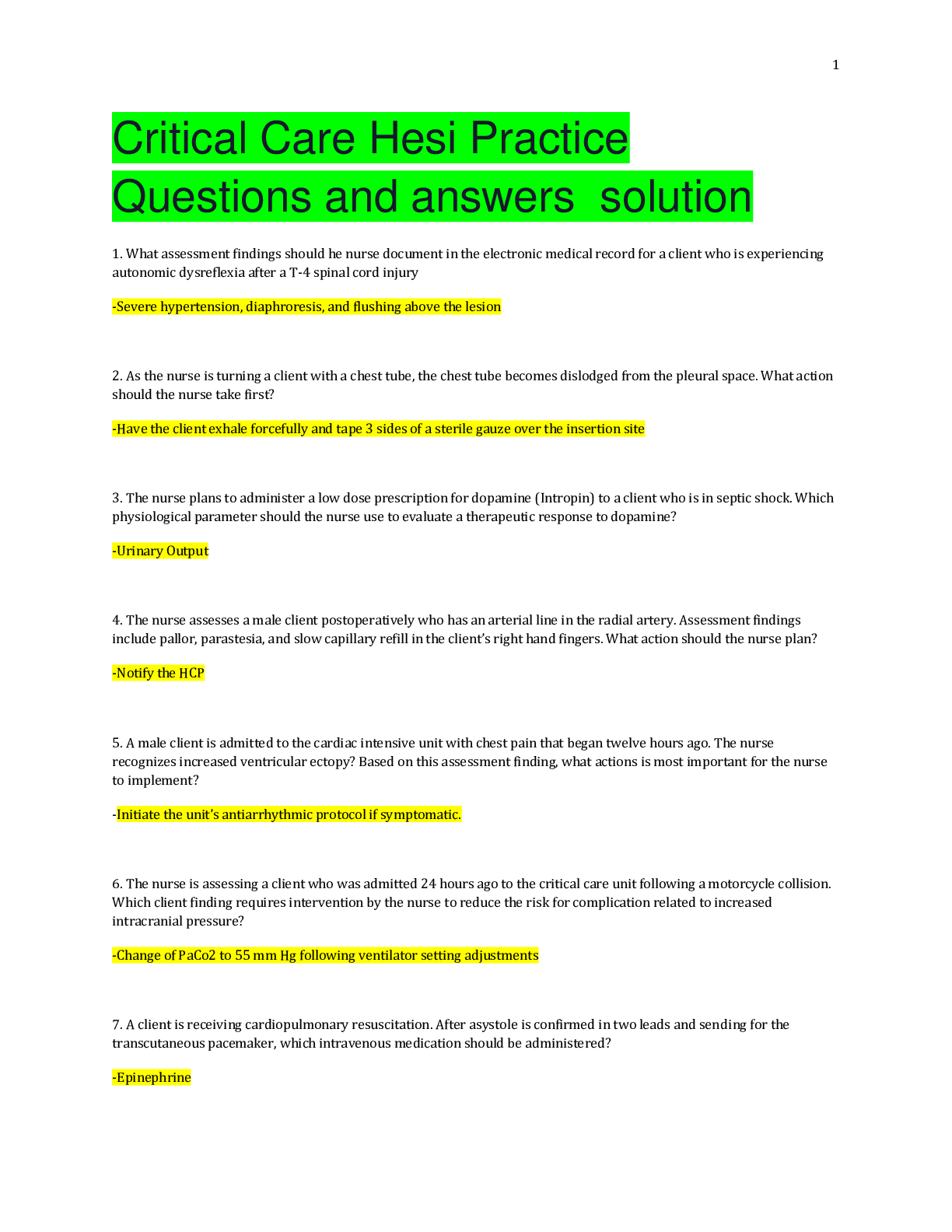
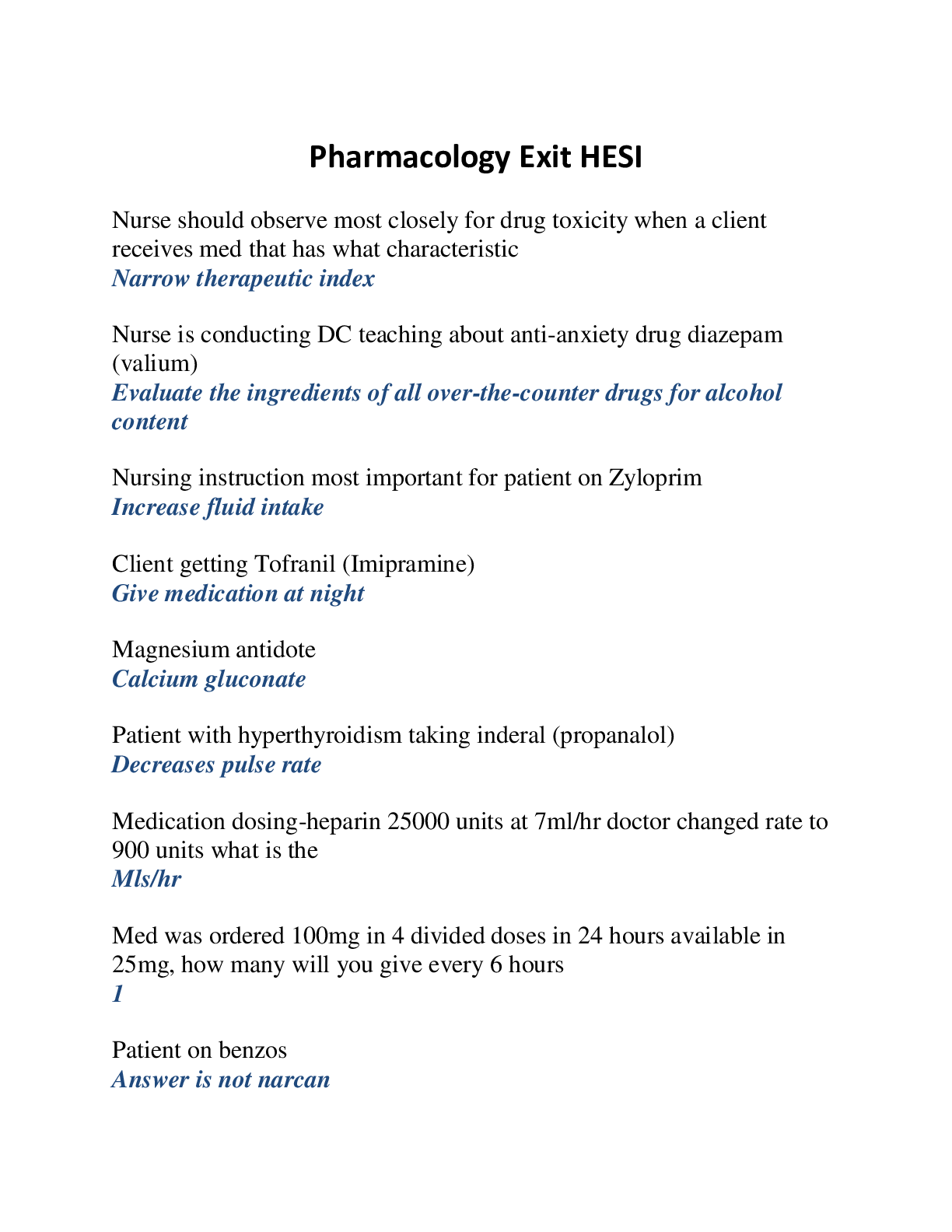
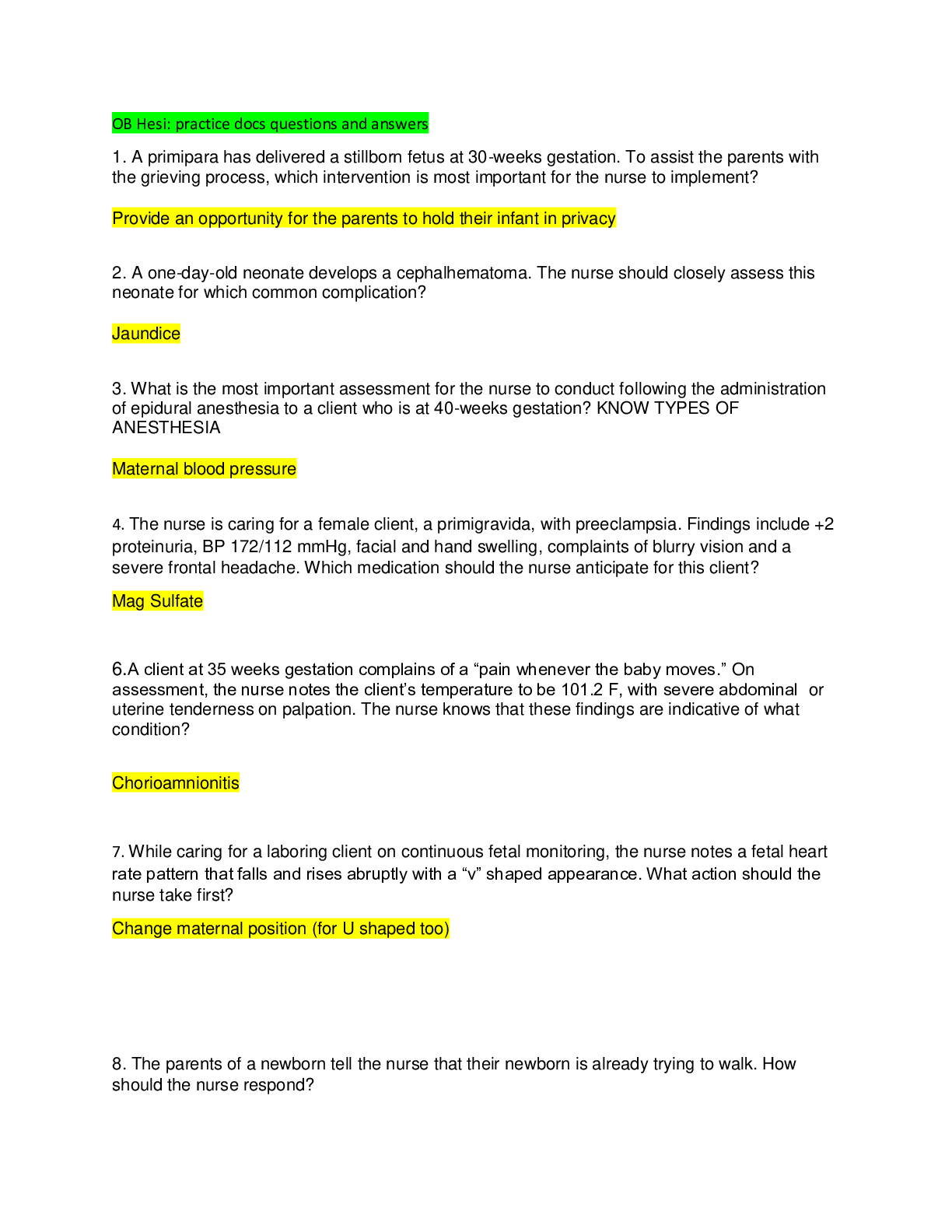



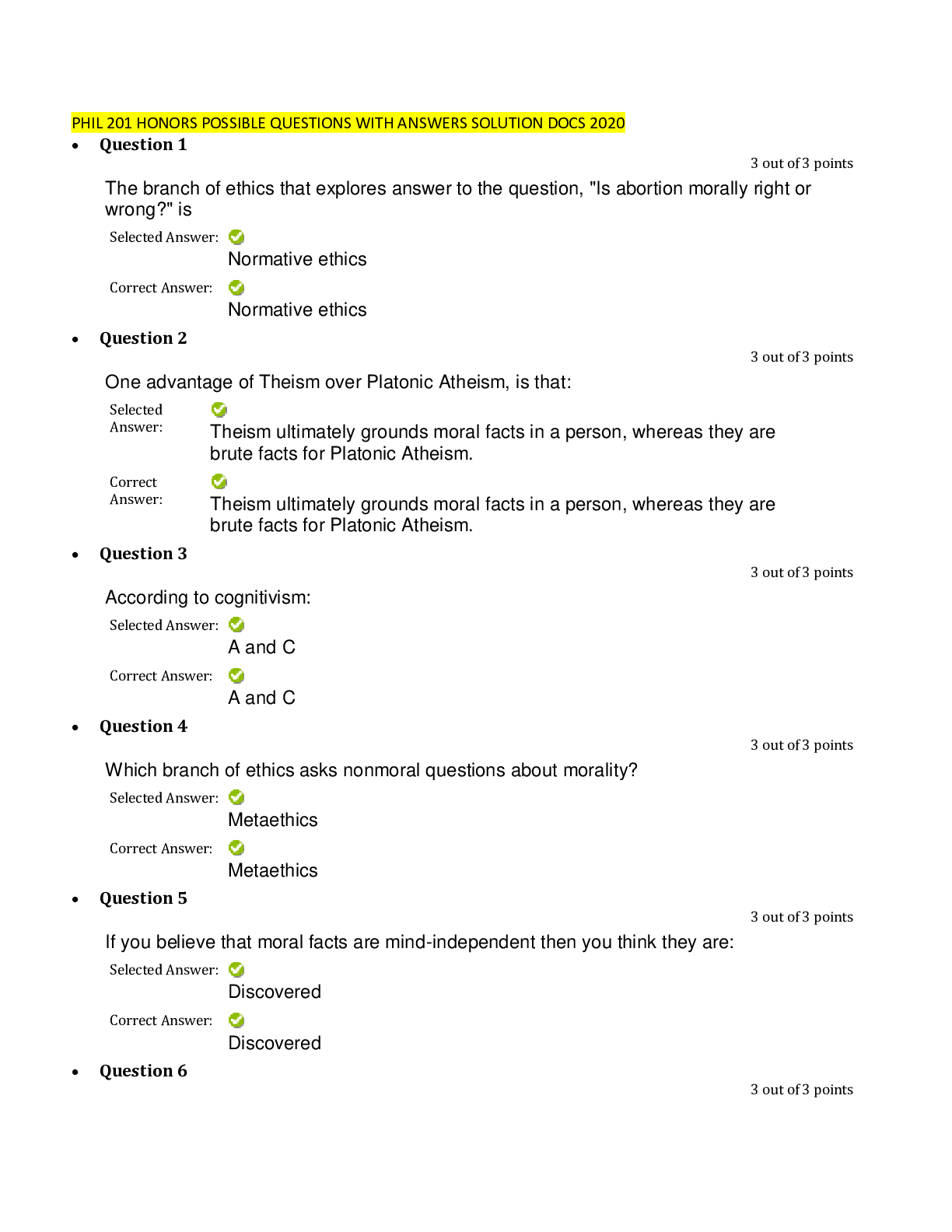
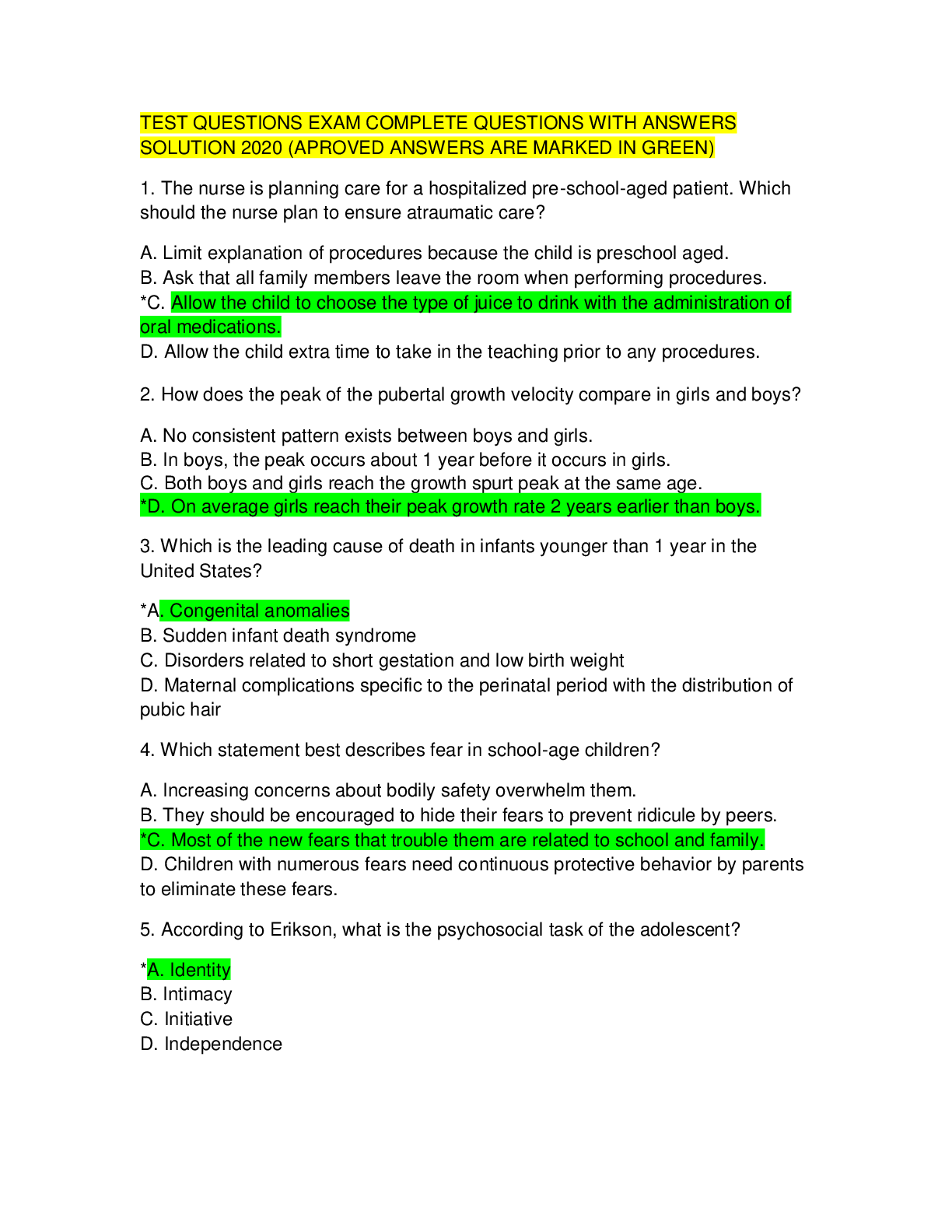
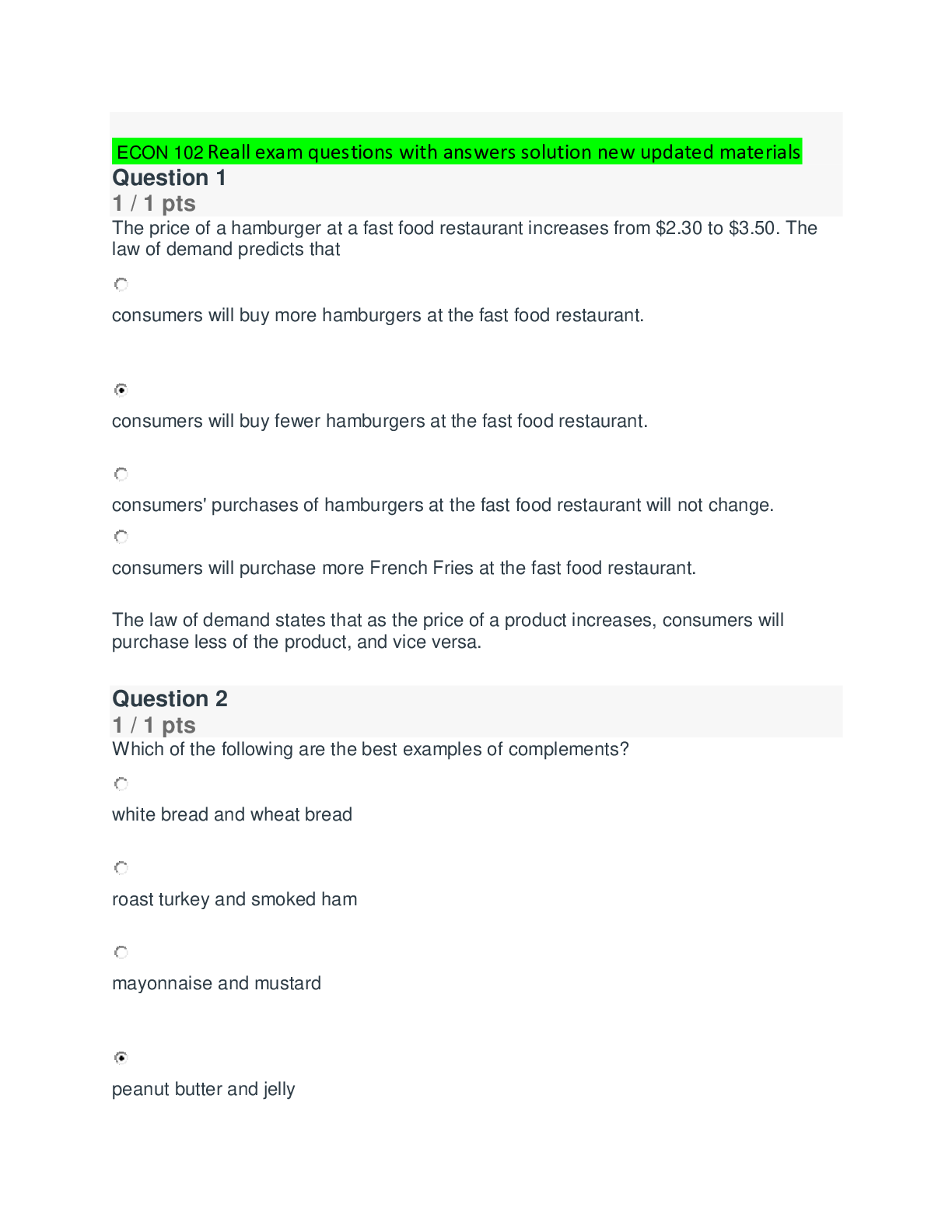
.png)
 answers (1).png)
